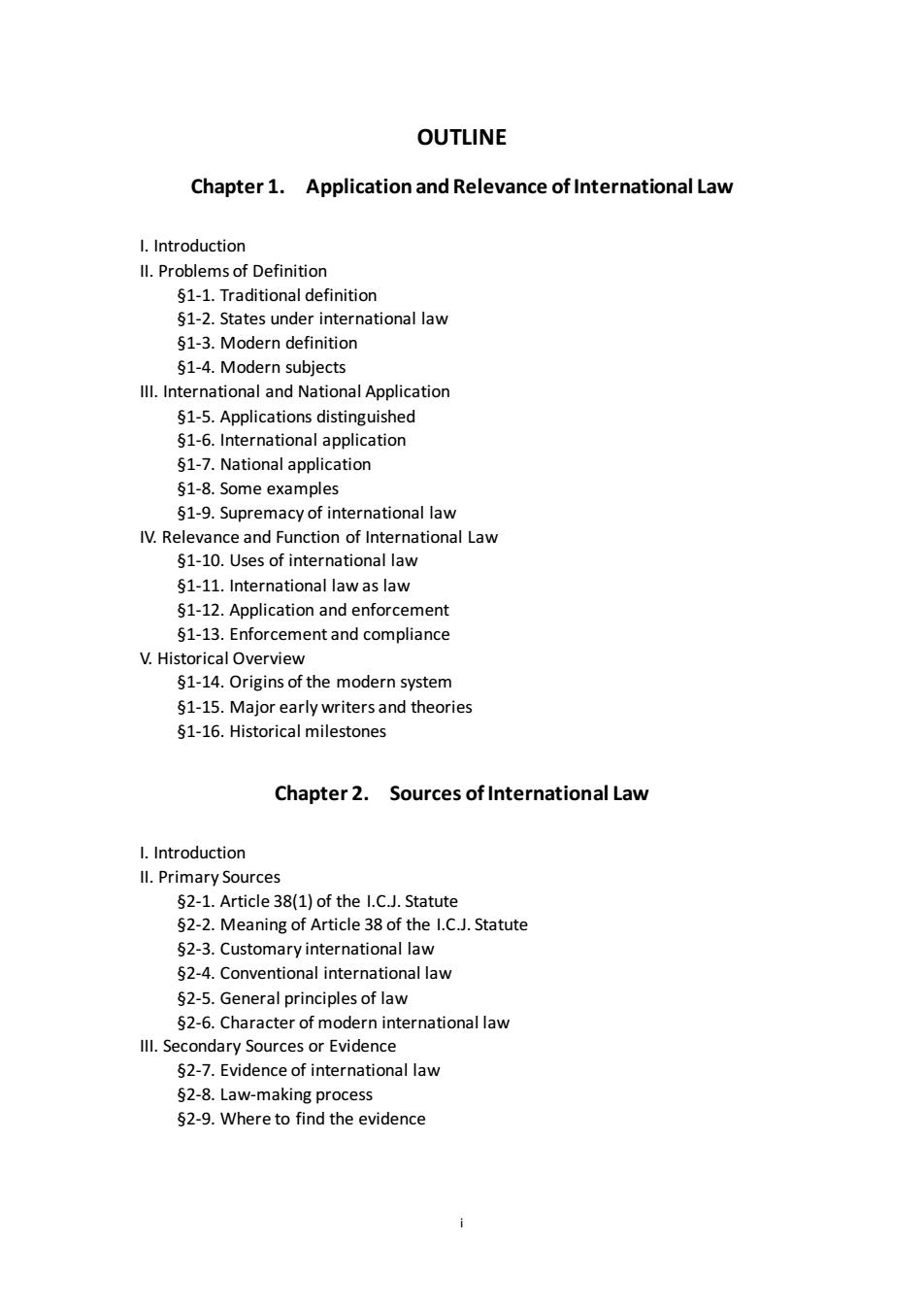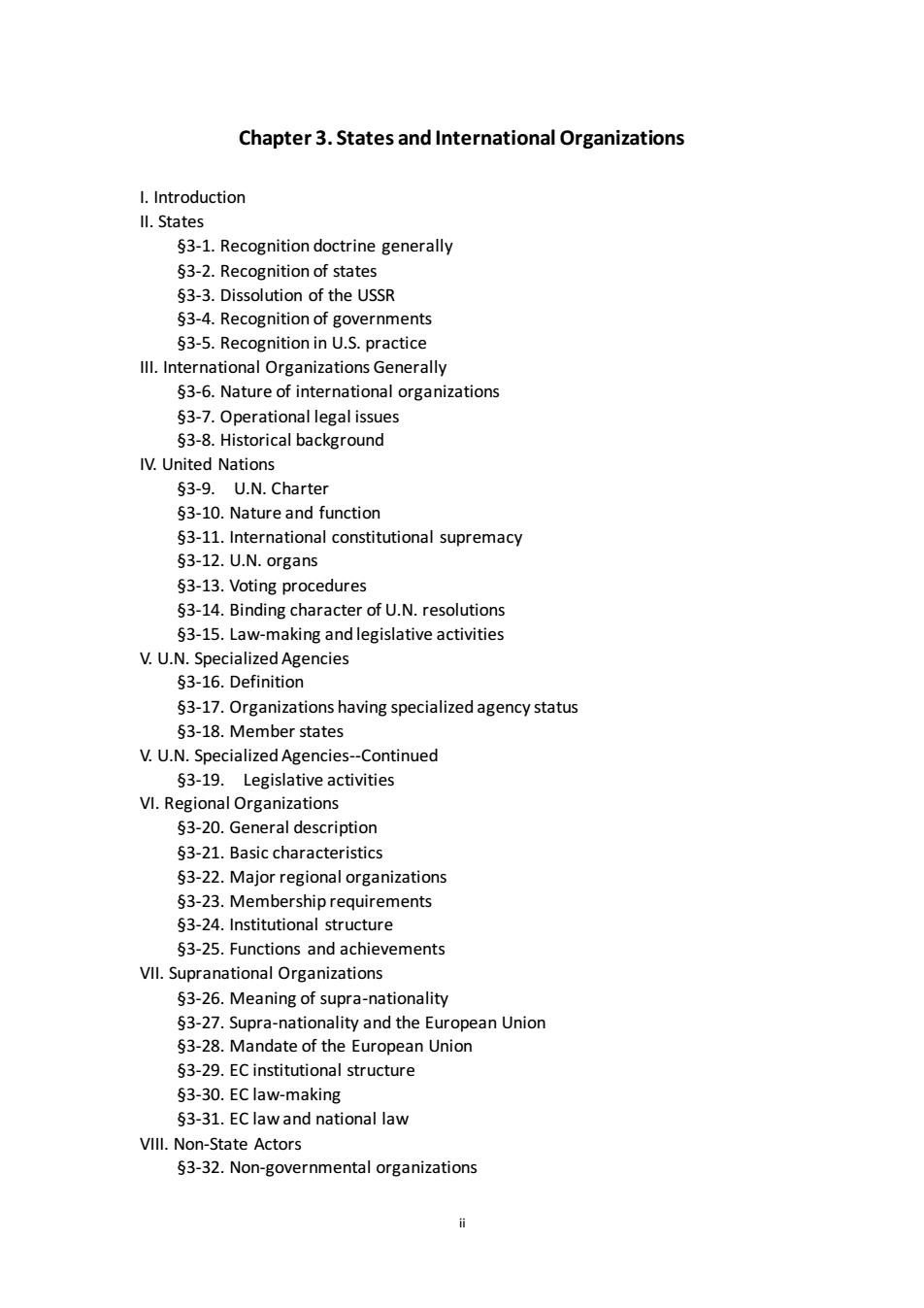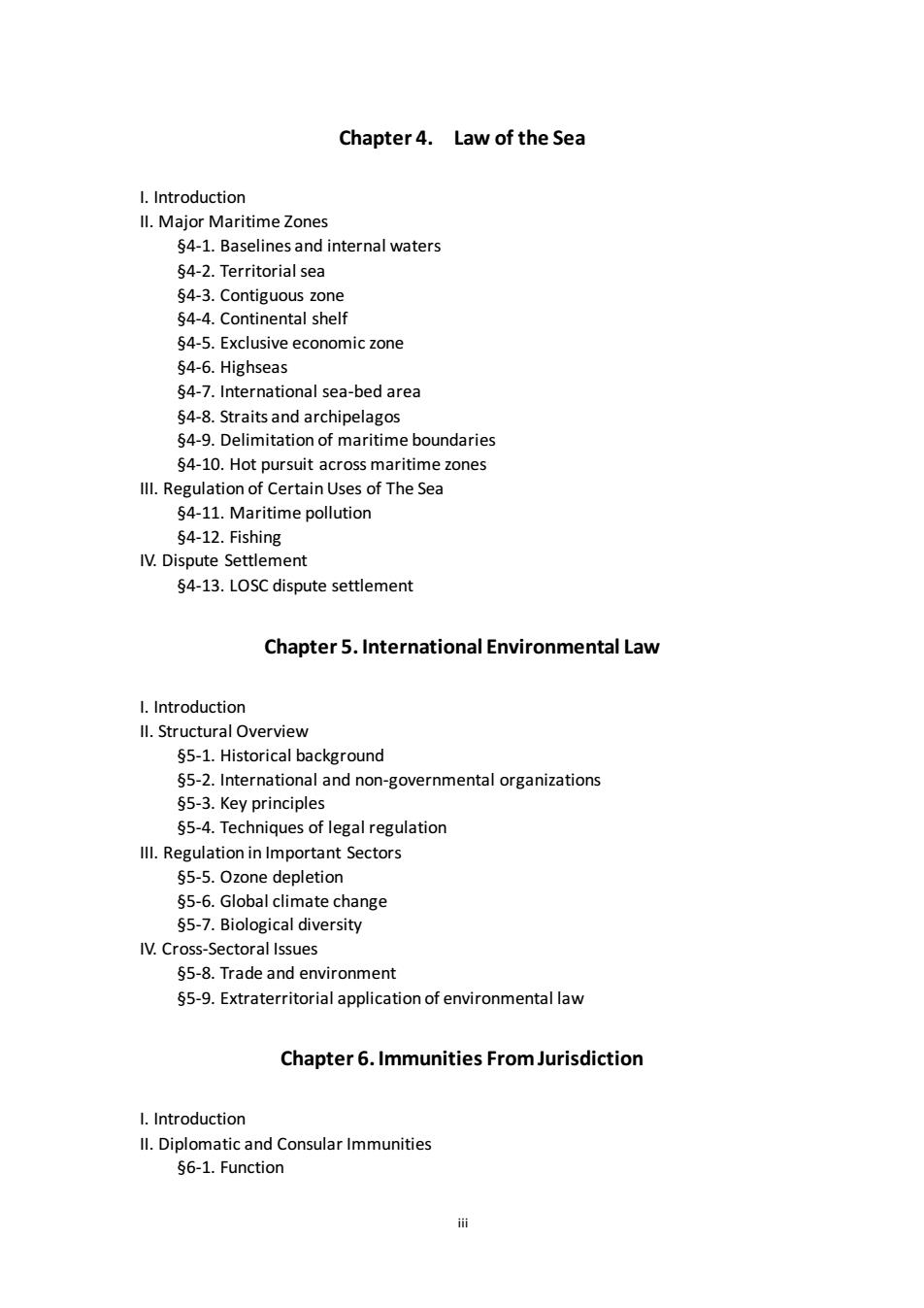
国际法教案(英文) PUBLIC INTERNATIONAL LAW (校内教学参考书) 新疆大学法学院国际法项目组 2008年12月
国际法教案(英文) (校内教学参考书) 新疆大学法学院国际法项目组 2008 年 12 月

说明 本教材仅在新疆大学法学院范围内,作为高年级本科生的双语教 学试验参考书使用,特此说明。 编者 2008年12月
说 明 本教材仅在新疆大学法学院范围内,作为高年级本科生的双语教 学试验参考书使用,特此说明。 编 者 2008 年 12 月

OUTLINE Chapter 1.Application and Relevance of International Law L Introduction Il.Problems of definition .Traditional definitio s1-2. tes und r international law 51-3.Modern definition 61-4.Modern subiects Ill.International and National Application $1-7.National application 51-8.Some examples 51-9.Supremacy of international law IV.Relevance and Function of International Law 51-10.Uses of in national law $1-11.International law as law 51-12.Application and enforcement $1-13.Enforcement and compliance V.Historical Overview $1-14.Origins of the modern syste em 15.Major theories 51-16.Historical milestones Chapter 2.Sources of International Law I.Introduction Il.Primary Sources 52-1.Article38(1)of the I.C.J.Statute 52-2.Meaning of Article 38 of the I.C.J.Statute $2-3.Customaryinte ational law $2-4.Conventional international law 52-5.General principles of law $2-6.Character of modern international law Ill.Secondary Sources or Evidence 52-7.Evidence of international law S2-8.Law-making proc 52-9.Where to find the evidence
i OUTLINE Chapter 1. Application and Relevance of International Law I. Introduction II. Problems of Definition §1-1. Traditional definition §1-2. States under international law §1-3. Modern definition §1-4. Modern subjects III. International and National Application §1-5. Applications distinguished §1-6. International application §1-7. National application §1-8. Some examples §1-9. Supremacy of international law IV. Relevance and Function of International Law §1-10. Uses of international law §1-11. International law as law §1-12. Application and enforcement §1-13. Enforcement and compliance V. Historical Overview §1-14. Origins of the modern system §1-15. Major early writers and theories §1-16. Historical milestones Chapter 2. Sources of International Law I. Introduction II. Primary Sources §2-1. Article 38(1) of the I.C.J. Statute §2-2. Meaning of Article 38 of the I.C.J. Statute §2-3. Customary international law §2-4. Conventional international law §2-5. General principles of law §2-6. Character of modern international law III. Secondary Sources or Evidence §2-7. Evidence of international law §2-8. Law-making process §2-9. Where to find the evidence

Chapter 3.States and International Organizations I.Introduction Il.States $3-1.Recognition doctrine generally 53.2Re nition of states 53-4.Recognition of governments 53-5.Recognition in U.S.practice lL International organizations generally $3-6.Nature of international organizations 3-7.peratin 3-8.Historical backgroun IV.United Nations 53-9.U.N.Charter $3-10.Nature and function 63-11 Inter national constitutional supremacy 53-12.U.N.0rgan 53-13.Voting procedures $3-14.Binding character of U.N.resolutions 53-15.Law-making and legislative activities V.U.N.SpecializedAgencies $3-16.Definitior 53-17.Organizations having specialized agency status 53-18.Member states V.U.N.Specialized Agencies-Continued 53-19.Legislative activities VI.Re onal Orga 3-20.General description 53-21.Basic characteristics $3-22.Major regional organizations 53-23.Membership reguirements 53-24 Institutional str ucture $3-25.Functio s and achie ements VII.Supranational Organizations 53-26.Meaning of supra-nationality 53-27.Supra-nationality and the European Union S3-28.Mandate of the European Union 63-29.ECinstitut al str 53-30.EClaw-making 53-31.EC law and national law VIll.Non-State Actors 53-32.Non-governmental organizations
ii Chapter 3. States and International Organizations I. Introduction II. States §3-1. Recognition doctrine generally §3-2. Recognition of states §3-3. Dissolution of the USSR §3-4. Recognition of governments §3-5. Recognition in U.S. practice III. International Organizations Generally §3-6. Nature of international organizations §3-7. Operational legal issues §3-8. Historical background IV. United Nations §3-9. U.N. Charter §3-10. Nature and function §3-11. International constitutional supremacy §3-12. U.N. organs §3-13. Voting procedures §3-14. Binding character of U.N. resolutions §3-15. Law-making and legislative activities V. U.N. Specialized Agencies §3-16. Definition §3-17. Organizations having specialized agency status §3-18. Member states V. U.N. Specialized Agencies-Continued §3-19. Legislative activities VI. Regional Organizations §3-20. General description §3-21. Basic characteristics §3-22. Major regional organizations §3-23. Membership requirements §3-24. Institutional structure §3-25. Functions and achievements VII. Supranational Organizations §3-26. Meaning of supra-nationality §3-27. Supra-nationality and the European Union §3-28. Mandate of the European Union §3-29. EC institutional structure §3-30. EC law-making §3-31. EC law and national law VIII. Non-State Actors §3-32. Non-governmental organizations

Chapter4.Law of the Sea I.Introduction Il.Major Maritime Zones $4-1.Baselines and internal waters $4-2.Territorial sea $4-5.Exclusive economic zone 54-6.Highseas 54-7.International sea-bed area 54-9.Del nof maritime boundarie 54-10.Hot pursuit across maritime zones Ill.Regulation of Certain Uses of The Sea $4-11.Maritime pollution 54-12.Fishing IV.Dispute Settle ent $4-13.LOSC dispute settlement Chapter 5.International Environmental Law ll.Structural Overview 55-1.Historical background 55-2.International and non-governmental organizations $5-3.Key principles $5-4.Techniques of legal regulation Ill.Regulation in Important Sectors 55-5.Ozone depletion 55-6.Global climate change 55-7.Biological diversity IV.Cross-Sec ral Issues $5-8.Trade and environment 55-9.Extraterritorial application of environmental law Chapter 6.Immunities FromJurisdiction I.Introduction ll.Diplomatic and Consular Immunities $6-1.Function
iii Chapter 4. Law of the Sea I. Introduction II. Major Maritime Zones §4-1. Baselines and internal waters §4-2. Territorial sea §4-3. Contiguous zone §4-4. Continental shelf §4-5. Exclusive economic zone §4-6. Highseas §4-7. International sea-bed area §4-8. Straits and archipelagos §4-9. Delimitation of maritime boundaries §4-10. Hot pursuit across maritime zones III. Regulation of Certain Uses of The Sea §4-11. Maritime pollution §4-12. Fishing IV. Dispute Settlement §4-13. LOSC dispute settlement Chapter 5. International Environmental Law I. Introduction II. Structural Overview §5-1. Historical background §5-2. International and non-governmental organizations §5-3. Key principles §5-4. Techniques of legal regulation III. Regulation in Important Sectors §5-5. Ozone depletion §5-6. Global climate change §5-7. Biological diversity IV. Cross-Sectoral Issues §5-8. Trade and environment §5-9. Extraterritorial application of environmental law Chapter 6. Immunities From Jurisdiction I. Introduction II. Diplomatic and Consular Immunities §6-1. Function